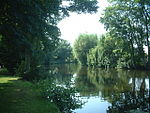Bixley

Bixley is a former civil parish now in the parish of Caistor St Edmund and Bixley, in the South Norfolk district of Norfolk, England. According to the 2001 census and 2011 census it contained 60 households and a population of 144. It covered an area south of Norwich including the village of Arminghall. On the 1st of April 2019 the parish was merged with Caistor St Edmund to form Caistor St Edmund and Bixley.The origin the name of Bixley has been studied in a paper by Keith Briggs; it means 'clearing in bushy land'. The name of Bixley near Ipswich has the same origin. The parish church of St Wandregesilius dates from 1272. St Wandregesilius is a Latinised form of St Wandrille and it is the only church dedicated to this 7th century French abbot. In May 2004 it was set on fire by arsonists and gutted. The church had no electricity and used gas cylinders for heating which it is believed were used by vandals to start the fire. Near the church is the site of a deserted medieval village.Sir Timothy Colman lived in Bixley Manor in the grounds of which is the seven-storey stump of Bixley Tower Mill dating from 1838. At eleven storeys this was once the tallest windmill in Norfolk and possibly the tallest in Britain. It was reduced to its current height in 1872.
Excerpt from the Wikipedia article Bixley (License: CC BY-SA 3.0, Authors, Images).Bixley
Bungay Road, South Norfolk Caistor St Edmund and Bixley
Geographical coordinates (GPS) Address Nearby Places Show on map
Geographical coordinates (GPS)
| Latitude | Longitude |
|---|---|
| N 52.60336 ° | E 1.329174 ° |
Address
Bungay Road
Bungay Road
NR14 7FR South Norfolk, Caistor St Edmund and Bixley
England, United Kingdom
Open on Google Maps








